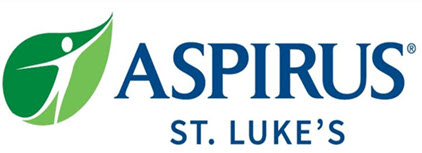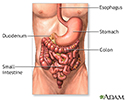Stool ova and parasites exam
Parasites and stool ova exam; Amebiasis - ova and parasites; Giardiasis - ova and parasites; Strongyloidiasis - ova and parasites; Taeniasis - ova and parasitesStool ova and parasites exam is a lab test to look for parasites or eggs (ova) in a stool sample. The parasites are associated with intestinal infections.
How the Test is Performed
A stool sample is needed.
There are many ways to collect the sample. You can collect the sample:
- On plastic wrap. Place the wrap loosely over the toilet bowl so that it is held in place by the toilet seat. Put the sample in a clean container given to you by your health care provider.
- In a test kit that supplies a special toilet tissue. Put it in a clean container given to you by your provider.
Do not mix urine, water, or toilet tissue with the sample.
For children wearing diapers:
- Line the diaper with plastic wrap.
- Position the plastic wrap so that it will prevent urine and stool from mixing. This will provide a better sample.
Return the sample to your provider's office or lab as directed. At the lab, a small smear of stool is placed on a microscope slide and examined.
How the Test will Feel
The laboratory test does not involve you. There is no discomfort.
Why the Test is Performed
Your provider may order this test if you have signs of parasites, diarrhea that does not go away, or other intestinal symptoms.
Normal Results
There are no parasites or eggs in the stool sample.
Talk to your provider about the meaning of your test results.
What Abnormal Results Mean
An abnormal result means parasites or eggs are present in the stool. This is a sign of a parasitic infection, such as:
-
Amebiasis
Amebiasis
Amebiasis is an infection of the intestines. It is caused by the microscopic parasite Entamoeba histolytica.
 ImageRead Article Now Book Mark Article
ImageRead Article Now Book Mark Article -
Giardiasis
Giardiasis
Giardia, or giardiasis, is a parasitic infection of the small intestine. A tiny parasite called Giardia lamblia causes it.
 ImageRead Article Now Book Mark Article
ImageRead Article Now Book Mark Article -
Strongyloidiasis
Strongyloidiasis
Strongyloidiasis is an infection with the roundworm Strongyloides stercoralis (S stercoralis).
 ImageRead Article Now Book Mark Article
ImageRead Article Now Book Mark Article -
Taeniasis
Taeniasis
Beef or pork tapeworm infection is an infection with the tapeworm parasite found in beef or pork.
 ImageRead Article Now Book Mark Article
ImageRead Article Now Book Mark Article
Risks
There are no risks.
References
DuPont HL, Okhuysen PC. Approach to the patient with suspected enteric infection. In: Goldman L, Schafer AI, eds. Goldman-Cecil Medicine. 26th ed. Philadelphia, PA: Elsevier; 2020:chap 267.
Plourde AR, Beavis KG. Specimen collection and handling for diagnosis of infectious diseases. In: McPherson RA, Pincus MR, eds. Henry's Clinical Diagnosis and Management by Laboratory Methods. 24th ed. Philadelphia, PA: Elsevier; 2022:chap 66.
Siddiqi HA, Rabinowitz S, Axiotis CA. Laboratory diagnosis of gastrointestinal and pancreatic disorders. In: McPherson RA, Pincus MR, eds. Henry's Clinical Diagnosis and Management by Laboratory Methods. 24th ed. Philadelphia, PA: Elsevier; 2022:chap 23.
Wojewoda CM, Stempak LM. Medical bacteriology. In: McPherson RA, Pincus MR, eds. Henry's Clinical Diagnosis and Management by Laboratory Methods. 24 th ed. Philadelphia, PA: Elsevier; 2022:chap 57.
-
Lower digestive anatomy - illustration
Food passes from the stomach into the small intestine. In the small intestine all nutrient absorption occurs. Whatever has not been absorbed by the small intestine passes into the colon. In the colon most of the water is absorbed from the food residue. The residue is then eliminated from the body as feces.
Lower digestive anatomy
illustration
-
Lower digestive anatomy - illustration
Food passes from the stomach into the small intestine. In the small intestine all nutrient absorption occurs. Whatever has not been absorbed by the small intestine passes into the colon. In the colon most of the water is absorbed from the food residue. The residue is then eliminated from the body as feces.
Lower digestive anatomy
illustration
Review Date: 5/6/2022
Reviewed By: Michael M. Phillips, MD, Emeritus Professor of Medicine, The George Washington University School of Medicine, Washington, DC. Also reviewed by David C. Dugdale, MD, Medical Director, Brenda Conaway, Editorial Director, and the A.D.A.M. Editorial team.




